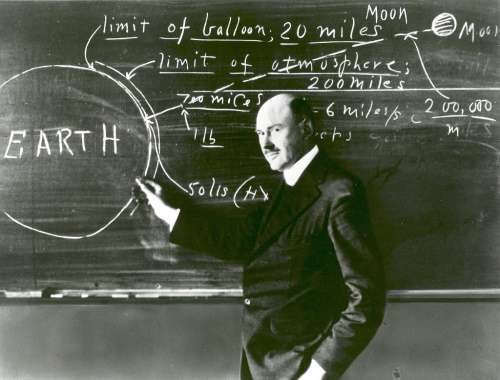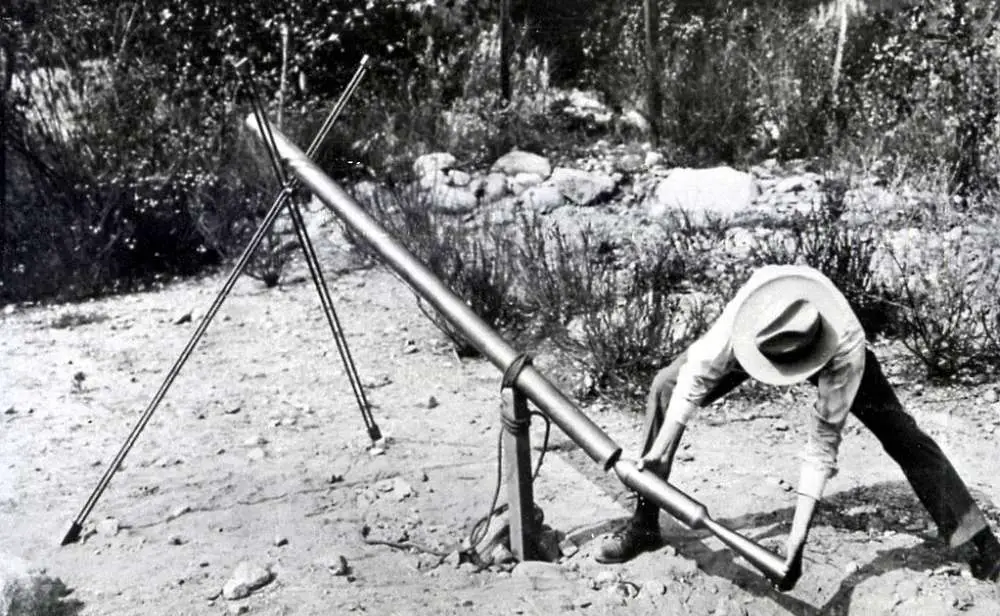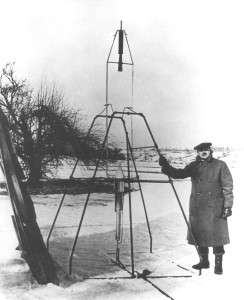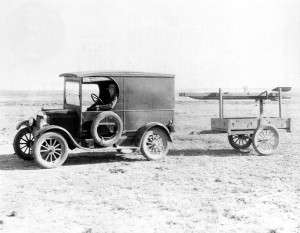As a teenager, Worcester’s Robert Goddard climbed a cherry tree on his family farm on Oct. 19, 1899 and dreamed of building a rocket that would fly to Mars. That day, the 17-year-old envisioned the principles of rocket propulsion that would, in fact, take a rocket to space.
“I was a different boy when I descended the tree . . . for existence at last seemed very purposeful,” he said.
For the rest of his life, he considered that day his “Anniversary Day.”

Goddard teaching at Clark University
But the journey from dream to reality was not an easy one. He didn’t receive acknowledgement for his achievements until well after he died. And only after a man landed on the moon did one of his fiercest critics apologize.
Robert Goddard
Robert Goddard was born on a Worcester farm on Oct. 5, 1882, the only son of Nahum Goddard and Fannie Hoyt to survive infancy. As a frail boy prone to illness, he read voraciously about science.
He graduated from Worcester Polytechnic Institute in 1908 and earned his master’s and Ph.D. in physics from Clark University.
Robert Goddard turned his attention to the possibility of fueling a rocket with liquid hydrogen and liquid oxygen. His views on fueling a rocket toward space and then propelling it in the vacuum of space generated controversy.
Scientists debated the merits of his proposals. And The New York Times sniffed at the theories of a scientist from western Massachusetts:
“That Professor Goddard, with his “chair” in Clark College and the countenancing of the Smithsonian Institution, does not know the relation of action and reaction, and of the need to have something better than a vacuum against which to react—to say that would be absurd. Of course he only seems to lack the knowledge ladled out daily in high schools.”
The Auburn Rocket
Goddard was undeterred. He did, however, tend to keep his work quiet after the early controversies. He wanted to avoid wasting time defending himself against his less- knowledgeable critics.
On March 16, 1926, he launched his first rocket on a relative’s farm in Auburn, Mass. That first flight, just 41-feet high, inspired him to try more, and he would continue using the Asa Ward farm in Auburn for several more launches.
The noise of the rockets, however, and their tendency to go astray and land with a thud generated more and more police calls. A newspaper headline from the day after a July 17, 1929 launch told the story: “Giant Rocket Alarms Many.”
Another snarky headline announced, “Moon Rocket Misses Target by 238,799 1/2 Miles!”
A rocket is a noisy thing, Robert Goddard explained. But the test caused no damage. Nevertheless, state fire marshal George Neal ordered an end to the tests. Goddard next successfully persuaded the military to let him use the grounds at Camp Devens for his tests, which put him outside the reach of the state authorities. He worked there for roughly a year.
Charles Lindbergh Steps In
But another party had also taken notice of Goddard’s work. Robert Goddard’s ideas impressed aviator Charles Lindbergh. Lindbergh checked him out and then began turning to his wealthy friends to find support. Lindbergh would convince the Harry Guggenheim (of Guggenheim Foundation fame) to support Robert Goddard. With Guggenheim’s funding Goddard found an environment much more practical for his test launches: Roswell, N.M.
Over the next dozen years, Goddard’s research and the work of many other contributors would lead to the creation of rockets capable of traveling into space. Though he would have to sue the U.S. government to collect money for the use of his early patents, Robert Goddard would finally be acknowledged as the father or modern rocketry.
In 1969, long after his death in 1945, Goddard would have been pleased to note the final capitulation of his critics. Forty-nine years after its first editorial criticizing Goddard’s lack of understanding of basic physics, The New York Times wrote a correction in 1969, the day after the Apollo 11 moon launch that used Goddard’s inventions:
“Further investigation and experimentation have confirmed the findings of Isaac Newton in the 17th Century and it is now definitely established that a rocket can function in a vacuum as well as in an atmosphere. The Times regrets the error.”
This story about Robert Goddard was updated in 2022.




6 comments
After Werner von Braun was captured when Germany fell in WWII, his US Army interrogators asked him about the V2 early development – he told them – “first ask your own man Goddard, who did the work”…(I forget the written source at the moment)
Wikipedia:
“In 1963, von Braun reflected on the history of rocketry, and said of Goddard’s work: “His rockets … may have been rather crude by present-day standards, but they blazed the trail and incorporated many features used in our most modern rockets and space vehicles.”[8] Goddard confirmed his work was used by von Braun in 1944, shortly before the Nazis began firing V-2s at England. A V-2 crashed in Sweden and some parts were sent to an Annapolis lab where Goddard was doing research for the Navy. If this was the so-called Bäckebo Bomb, it had been procured by the British in exchange for Spitfires; Annapolis would have received some parts from them. Goddard is reported to have recognized components he had invented, and inferred that his brainchild had been turned into a weapon.”…Von Braun went on to use the same technology to direct the Apollo Program that put Man on the Moon…Goddard was NASA’s unofficial first engineer…
Very interesting.
shared!
Does this have any connection to Goddard College?
[…] to him. Ultimately, though, Marvin Hewitt, at age 34, wound up designing satellites for a Maryland technology company and publishing papers on his […]
[…] descendants include rocket scientist Robert Goddard, suffragist Susan B. Anthony, U.S. Secretary of War Henry Stimson and actress Raquel […]
Comments are closed.